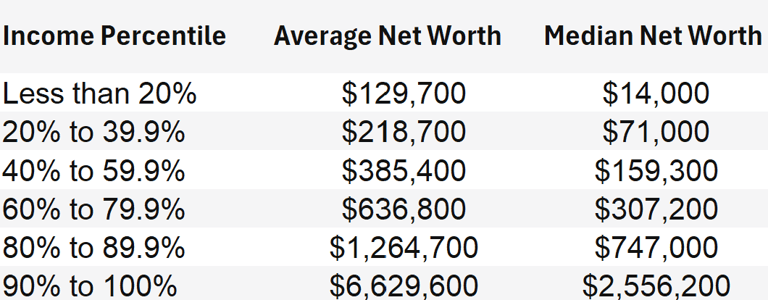A Strategic Approach for using Debt to Build Wealth
Leveraging debt strategically can be a powerful tool for building wealth. When managed wisely, debt can facilitate investments in assets that appreciate over time, thereby enhancing financial well-being.
Finistack
3/9/20253 min read


Debt is often viewed negatively, but when used strategically, it can be a powerful tool for wealth creation. In the United States, household debt varies significantly across different socioeconomic classes, impacting financial stability and net worth. Understanding how to leverage debt effectively can help individuals across all income levels build long-term wealth.
Understanding Productive vs. Unproductive Debt
Not all debt is created equal. Productive debt is used to acquire assets that appreciate or generate income, such as real estate, education, or business investments. Unproductive debt, such as high-interest credit card balances for discretionary spending, can hinder financial growth.
What does debt mean to different socioeconomic classes?
As of 2025, American households collectively hold approximately $18.036 trillion in debt, averaging $105,056 per household. This encompasses various debt forms, including mortgages, student loans, auto loans, and credit card debt. Analyzing household debt across different socioeconomic classes in the United States reveals significant disparities. While precise figures on average debt levels by specific net worth percentiles are limited, available data offers insights into debt distribution relative to net worth.
Debt-to-Asset Ratio
A key indicator of financial health is the debt-to-asset ratio, representing total debt as a percentage of total assets. In 2021, U.S. households had a median debt-to-asset ratio of 30%, a decrease from 35% in 2019, suggesting improved financial solvency (pewresearch.org).
Lower-Income Households: Median net worth of $24,500.
Middle-Income Households: Median net worth of $204,100.
Upper-Income Households: Median net worth of $803,400.
Furthermore, the top 10% of households possess wealth exceeding $1,559,240, while the top 1% hold at least $11,640,000 (richmondfed.org).
How Different Socioeconomic Classes Use Debt?
Lower-Income Households
Median net worth: $24,500
Higher reliance on student loans and consumer debt
More likely to experience negative net worth (liabilities exceed assets)
Strategic Move: Focus on education investments with strong return potential and limit high-interest debt.
Middle-Income Households
Median net worth: $204,100
Homeownership and retirement savings are key assets
Median debt-to-asset ratio: 30% (down from 35% in 2019)
Strategic Move: Use mortgage leverage wisely, maintain emergency savings, and invest in diversified assets.
Upper-Income Households
Median net worth: $803,400
More likely to hold investment properties and business equity
Lower overall debt-to-asset ratios
Strategic Move: Utilize tax-advantaged investment vehicles and business debt for expansion opportunities.
Wealth Distribution and Net Worth
According to investopedia.com, net worth varies significantly across different socioeconomic class.
2022 Average and Median Net Worth For Different Income Level


Smart Ways to Use Debt for Wealth Building
1. Real Estate Investments
Mortgages are one of the most common ways Americans use debt to build wealth. Real estate appreciates over time, and rental properties provide passive income. Recent data highlights homeownership as a major wealth-building avenue. (Investopedia)
2. Investing in Education
Higher education can significantly increase earning potential. However, student loans should be approached strategically—choosing fields with strong job prospects ensures a better return on investment.
3. Entrepreneurship and Business Expansion
Debt can fuel business growth. For instance, Blackstone recently raised an $8 billion real estate debt fund, highlighting the role of leverage in wealth accumulation. (WSJ)
4. High-Yield Savings and Investments
To protect wealth from inflation, individuals can utilize high-yield savings accounts, Treasury Inflation-Protected Securities (TIPS), and diversified investment portfolios.
*We will go into the details of each topic above on Finistack.com.
The Risks of Debt Mismanagement
While debt can be a tool for building wealth, mismanagement leads to financial instability. The 2008 financial crisis underscored the dangers of excessive and poorly structured debt. Today, the structured finance market is larger than ever, reinforcing the need for cautious borrowing. (WSJ)
Conclusion
Debt, when used strategically, can be a powerful tool for wealth accumulation. Whether through homeownership, education, business investments, or high-return savings options, individuals across different income levels can leverage debt to their advantage. However, careful planning and responsible borrowing are essential to avoid financial pitfalls and ensure long-term stability.
**Disclaimer: This blog may include AI-generated content derived from web crawling, and it features quotes from original cited inline or public sources. The information presented is for general informational purposes only and may not reflect the most current data or information available. While we strive for accuracy, we encourage readers to verify the information from original sources or reach out to a certified financial adviser for important financial decisions.
